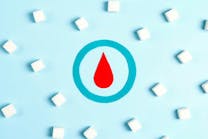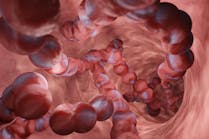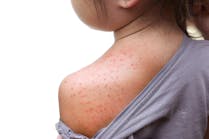Neonatal hyperbilirubinemia tests
Q
Our neonatologist is interested in screening for glucose-6-phosphate dehydrogenase (G6PD) for the evaluation of hyperbilirubinemia of newborns. There is a color reduction test that has a degree of accuracy similar to the fluorescent technique (World Health Organization's preferred test). Can you explain about these tests?
A In 2004, the American Academy of Pediatrics established a practice guideline for the determination of hyperbilirubinemia in term infants.1 The guideline recommends that total serum-bilirubin levels should be obtained from infants prior to discharge and its interpretation assisted by an hour-specific age nomogram. This risk assessment should also include consideration of additional factors that may contribute to the risk of acquiring neonatal hyperbilirubinemia. The risk factors are categorized into major, minor, and decreased risk groups. Major risk factors include a high-risk zone total serum-bilirubin level; jaundice within the first 24 hours; gestational age of 35 weeks to 36 weeks; previous sibling to have received phototherapy; significant bruising; exclusive breastfeeding; East Asian race; and blood-group incompatibility or other known hemolytic disease such as G6PD deficiency.
G6PD is an enzyme that catalyzes the first step in the pentose-phosphate pathway, a pathway that produces the reduced form of nicotinamide adenine dinucleotide phosphate (NADPH) for red blood cells. NADPH is used by the cell to protect it from oxidative stress. NADPH, for example, will maintain glutathione in the reduced state, which catalyzes the breakdown of the oxidative compound H2O2. In G6PD deficiency, the decreased NADPH levels result in cell membranes that are vulnerable to oxidative injury, which may lead to hemolytic disease. G6PD deficiency is an X-linked genetic defect caused by mutations in the G6PD gene. The wide variety of mutations lead to various decreased levels of enzyme activity such that a wide range of clinical phenotypes are observed. The most common clinical signs are neonatal jaundice and acute hemolytic anemia, and, thus, their consideration as major risk factors for neonatal hyperbilirubinemia.
Methods for the screening of G6PD deficiency are relatively straightforward. All rely on the conversion by G6PD of glucose-6-phosphate to 6-phosphogluconate. In this reaction, G6PD uses NADP as a cofactor. Thus, the second step of these assays utilizes NADPH to reduce a compound to form a colored or fluorescent product for detection. A quick Internet search identified two manufacturers with G6PD-deficiency screening kits: Pointe Scientific and Trinity Biotech. Specimen requirements for the Pointe Scientific assay are 5 mL of whole blood with an incubation time period of up to one hour. In addition, each of these manufacturers has a quantitative G6PD method that can be used for verification and screening (depending on your patient volume) purposes. Specimen requirements for the Trinity Biotech assay are 10 mL of whole blood with several incubations requiring 30 to 40 minutes.
—Stanley F. Lo, PhD
Technical Director Clinical Chemistry
Children's Hospital of Wisconsin
Milwaukee, WI
References
- American Academy of Pediatrics, Subcommittee on Hyperbilirubinemia. Clinical practice guideline: management of hyperbilirubinemia in the newborn infant 35 or more weeks of gestation. Pediatrics. 2004;114:297-316.
Collecting coags in a syringe
Q I am concerned about the practice of collecting for all ordered tests with a 12-cc or 20-cc syringe and butterfly, and transferring to the appropriate tubes. Is this acceptable practice for coagulation tests?
A According to the Clinical Laboratory Standards Institute (CLSI)coagulation guideline, specimens for plasma-based coagulation studies can be collected directly into a tube (e.g., through a tube-holder assembly or drawn into a syringe and transferred into a tube).1 The syringe should be composed of a non-activating surface like polypropylene. A winged device is also acceptable when coupled with a tube holder or syringe. Most syringe draws are uncomplicated and do not result in a prolonged collection. Syringe draws that are prolonged, however, may risk clotting within the barrel of the syringe. Therefore, the guideline recommends that when drawing into a syringe, the syringe should be evacuated into the coagulation tube within one minute of completion of the draw. Due to the potential for blood to clot within the barrel of the device, syringe sizes of 20 mL or less are recommended. To protect against hemolysis, a slow, steady withdrawal of the plunger of the syringe is less likely to rupture red blood cells than pulling on the plunger with excessive force. The use of needles smaller than 23-gauge may also contribute to hemolysis. When evacuating the specimen into multiple tubes, follow the same CLSI-recommended order of draw as when using a tube holder.2 This order places the coagulation tube first (unless blood cultures are also being collected, in which case they would follow the blood culture).
—Dennis J. Ernst, MT(ASCP)
Director
Center for Phlebotomy Education
Corydon, IL
References
- CLSI. Collection, Transport, and Processing of Blood Specimens for Testing Plasma-based Coagulation Assays and Molecular Hemostasis Assays; Approved Guideline-Fifth Edition. CLSI document H21-A5. Wayne, PA: Clinical and Laboratory Standards Institute; 2008.
- CLSI. Procedures for the Collection of Diagnostic Blood Specimens by Venipuncture; Approved Standard—Sixth Edition. CLSI document H3-A6. Wayne, PA: Clinical and Laboratory Standards Institute; 2007.
Brad S. Karon, MD, PhD, is associate professor of laboratory medicine and pathology, and director of the Hospital Clinical Laboratories, point-of-care testing, and phlebotomy services at Mayo Clinic in Rochester, MN.
MLO's “Tips from the Clinical Experts” provides practical, up-to-date solutions to readers' technical and clinical issues from a panel of experts in various fields. Readers may send questions to Brad S. Karon, MD, PhD, by e-mail at [email protected].





